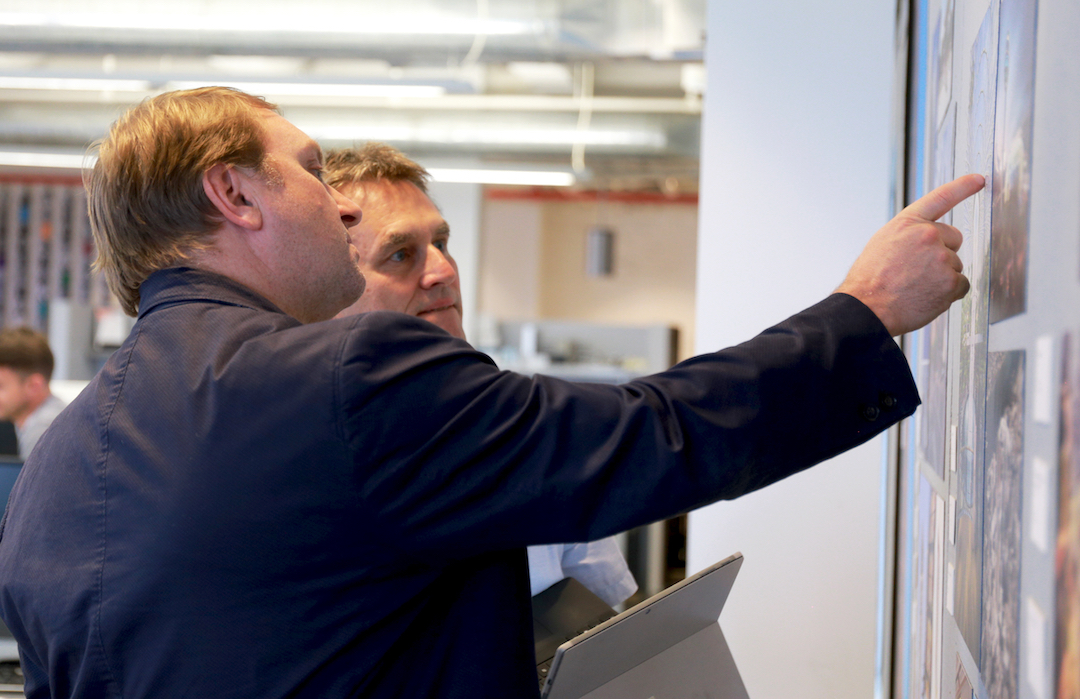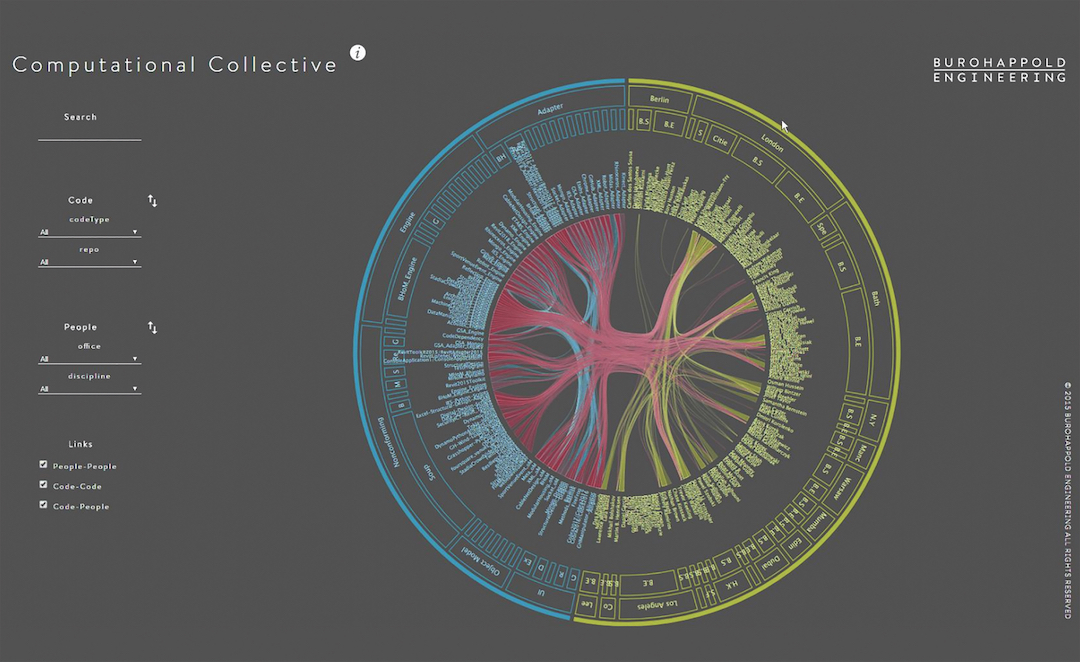Four years ago, at one of its technology gatherings, the engineering firm BuroHappold concluded that “we weren’t connected enough as a company,” recalls Craig Schwitter, PE, a Partner who has been with the firm since 1992 and leads its multidisciplinary projects.
To take advantage of available communications tools, Buro Happold formed its Computational Collective, which Schwitter says presents the firm’s employees with “a different way of thinking and working.”
Buro Happold's feedback loop
The Collective now has 400 members across all of the firm’s practices and offices. “It’s a way of democratizing technology, and all you have to do to be in the Collective is to contribute to it,” says Schwitter.
Where the Collective is about encouraging employees to interact, BuroHappold has also recently established a data exchange framework BHoM (for Buildings & Habitats object Model), which Schwitter says emerged from the Collective and allows for practical interfaces among teams. Last year, the firm unveiled its open-source website, BHoM.xyz.
BuroHappold has been moving in this collaborative direction for a while. One of its recent signature projects—the 1.4 million-sf retail and lifestyle complex at Jewel Changi Airport in Singapore, with its 131-foot-tall indoor rain vortex that pours from an oculus within a glass-domed roof—required the engagement of several of the firm’s offices, including New York, Boston, London, and Hong Kong. Schwitter agrees that this project could be viewed as a precursor to the Collective.
SEE ALSO: Clayco seeks the cutting edge as a competitive advantage
The ultimate goal of these changes, he says, is a process for tracking, measuring, and predicting human behavior for the purpose of designing and engineering better buildings. “How do you measure happiness, wellness? We see a future where we can measure the human experience. That’s like a light bulb going off for an engineer, and it’s a very motivating concept for me. But without data, we wouldn’t be able to even ask these questions.”
Innovations include digital twins for hospitals
Schwitter says BuroHappold is “very close” to being able to create digital twins for hospitals and other building types that incorporate human behavioral data. And one of Schwitter’s colleagues, Wolf Mangelsdorf, a Group Director and Partner with the firm, has formulated a “science of place” design strategy to multifamily housing, in what he calls “Wechselwirkungen.”
The intent is to reconcile design models and “interventions” that stem from community input with occupant and community needs, to create a continuous feedback loop that would define the criteria for deciding which design will works best.
 Craig Schwitter, PE (at left), a Partner, says the Computational Collective has changed the way people within the firm communicate and work together. Photo: Buro Happold
Craig Schwitter, PE (at left), a Partner, says the Computational Collective has changed the way people within the firm communicate and work together. Photo: Buro Happold

Related Stories
AEC Tech Innovation | Oct 8, 2024
New ABC technology report examines how AI can enhance efficiency, innovation
The latest annual technology report from Associated Builders and Contractors delves into how artificial intelligence can enhance efficiency and innovation in the construction sector. The report includes a resource guide, a case study, insight papers, and an essay concerning applied uses for AI planning, development, and execution.
3D Printing | Sep 13, 2024
Swiss researchers develop robotic additive manufacturing method that uses earth-based materials—and not cement
Researchers at ETH Zurich, a university in Switzerland, have developed a new robotic additive manufacturing method to help make the construction industry more sustainable. Unlike concrete 3D printing, the process does not require cement.
Airports | Aug 22, 2024
Portland opens $2 billion mass timber expansion and renovation to its international airport
This month, the Portland International Airport (PDX) main terminal expansion opened to passengers. Designed by ZGF for the Port of Portland, the 1 million-sf project doubles the capacity of PDX and enables the airport to welcome 35 million passengers per year by 2045.
Sustainability | Aug 14, 2024
World’s first TRUE Zero Waste for Construction-certified public project delivered in Calif.
The Contra Costa County Administration Building in Martinez, Calif., is the world’s first public project to achieve the zero-waste-focused TRUE Gold certification for construction. The TRUE Certification for Construction program, administered by Green Business Certification Inc. (GBCI), recognizes projects that achieve exceptional levels of waste reduction, reuse, and recycling.
Smart Buildings | Jul 25, 2024
A Swiss startup devises an intelligent photovoltaic façade that tracks and moves with the sun
Zurich Soft Robotics says Solskin can reduce building energy consumption by up to 80% while producing up to 40% more electricity than comparable façade systems.
Great Solutions | Jul 23, 2024
41 Great Solutions for architects, engineers, and contractors
AI ChatBots, ambient computing, floating MRIs, low-carbon cement, sunshine on demand, next-generation top-down construction. These and 35 other innovations make up our 2024 Great Solutions Report, which highlights fresh ideas and innovations from leading architecture, engineering, and construction firms.
AEC Tech Innovation | Jul 4, 2024
Caution competes with inevitability at conference exploring artificial intelligence for design and construction
Hosted by PSMJ, AEC Innovate in Boston found an AEC industry anxiously at the threshold of change.
Contractors | Jun 4, 2024
Contractors expect to spend more time on prefabrication, according to FMI study
Get ready for a surge in prefabrication activity by contractors. FMI, the consulting and investment banking firm, recently polled contractors about how much time they were spending, in craft labor hours, on prefabrication for construction projects. More than 250 contractors participated in the survey, and the average response to that question was 18%. More revealing, however, was the participants’ anticipation that craft hours dedicated to prefab would essentially double, to 34%, within the next five years.
AEC Tech | Apr 30, 2024
Lack of organizational readiness is biggest hurdle to artificial intelligence adoption
Managers of companies in the industrial sector, including construction, have bought the hype of artificial intelligence (AI) as a transformative technology, but their organizations are not ready to realize its promise, according to research from IFS, a global cloud enterprise software company. An IFS survey of 1,700 senior decision-makers found that 84% of executives anticipate massive organizational benefits from AI.
AEC Innovators | Apr 26, 2024
National Institute of Building Sciences announces Building Innovation 2024 schedule
The National Institute of Building Sciences is hosting its annual Building Innovation conference, May 22-24 at the Capital Hilton in Washington, D.C. BI2024 brings together everyone who impacts the built environment: government agencies, contractors, the private sector, architects, scientists, and more.

















